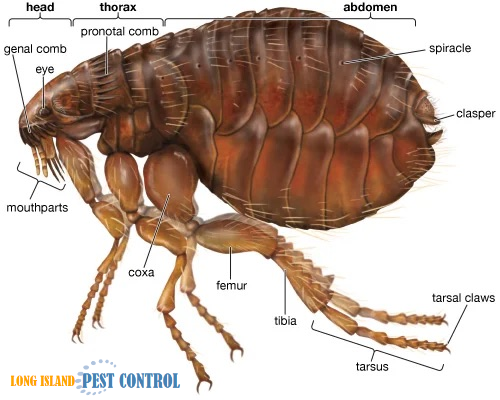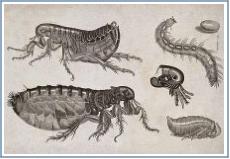
Fleas include 2,500 species of small flightless insects that exist as external parasites on warm-blooded animals. Fleas consume the blood of their hosts and are vectors for bacterial, viral, and rickettsial diseases in human beings and other animals. Although domestic cats and dogs are well-known flea hosts, rodents are most commonly afflicted by these parasites. The oriental rat flea is a vector of the bacterium which causes the bubonic plague. The bubonic plague is an infection spread to humans by infected fleas that travel on rodents, such as roof rats. The bubonic plague, also known as the black death, took the lives of millions of Europeans during the Middle Ages.



Flea bodies are divided into three parts: the head, thorax, and abdomen.

Fleas breathe through openings on their bodies called spiracles.

Fleas possess strong claws preventing them from being dislodged from their hosts.

Flea bodies are covered with hard plates called sclerites, which can withstand the pressure of a host animal scratching to eliminate them.

Flea mouthparts are modified for penetrating skin and sucking blood.

Fleas have three pairs of legs that are attached to their thorax. The hind legs are incredibly well adapted for jumping.

Flea adults are 1/8" long and are ordinarily brown.

Fleas have thin flat bodies, allowing them to move through their host's fur or feathers.
Fleas are insects that undergo complete metamorphosis. The flea lifecycle takes two to four weeks to complete under optimal conditions and consists of four stages: the egg, larva, pupa, and adult. In most flea species, neither males nor females are fully mature when they emerge but must consume blood before they can reproduce. Flea populations are made up of approximately 50% eggs, 35% larvae,10% pupae, and 5% adults. In some species of fleas, eggs are laid on the host and easily fall off onto the ground. Areas where the host animal rests and sleeps become one of the main habitats of flea eggs and developing larvae. Flea eggs take two days to two weeks to hatch. Flea larvae will emerge from the eggs and seek refuge in dark, humid places such as cracks and crevices or under carpets and in bedding. Larvae pupate and weave silken cocoons. The cocoons are impervious to insecticides, hindering flea control attempts. The larva will molt for a final time within the cocoon and be transformed into an adult flea. An adult flea will find blood and reproduce with a female laying as many as five thousand eggs in two to three months. Breaking the flea lifecycle is a critical component of flea control and prevention.




Cat fleas are the most common ectoparasite found on domestic animals. The cat flea lives on a wide variety of mammals, including domestic cats, dogs, and wild animals such as foxes, opossums, and raccoons. They cause flea bite dermatitis and transmit tapeworms. The tapeworm is transmitted when pets or humans swallow an immature flea.

Dog fleas, despite their name, they are not exclusively found on dogs. Dog flea hosts also include cats, humans, and wildlife. Like cat fleas, dog fleas can also transmit tapeworms. Dog flea infestations are rare in the United States.
Controlling fleas is a multistep process. Getting rid of a flea infestation at a Long Island home or business can be a complex process, even for the most experienced flea exterminator. Although many products are available to consumers that claim to get rid of fleas, research shows that the common cat flea has developed resistance to many flea control insecticides. In the absence of the proper training, equipment, and restricted use pesticides, the eradication of an infestation of fleas from your Long Island dwelling or place of business is an endeavor that will inevitably fail. Therefore, you should contact the Long Island flea control professionals at Long Island Pest Control. Our Long Island flea exterminating experts have an extensive knowledge of flea control and prevention strategies and many years of experience combating flea infestations.
Remediation and prevention of flea infestations usually entails the treatment of pets. However, when no pets are present, wildlife such as raccoons, opossums, squirrels, rats, or mice are responsible for the flea infestation in your home. In such cases, the pests should be removed by a nuisance wildlife control operator. Numerous types of products are available to control fleas on cats and dogs. Flea control medications are either given orally or applied topically to the pet. Not all flea control products are safe for all animals, so contact a veterinarian for advice on choosing the best medication. Management of fleas on pets must occur simultaneously with the regular and thorough cleaning of indoor and outdoor pet resting areas. Vacuuming is crucial to flea control and prevention because it removes many of the developing eggs, larvae, and pupae. Vacuuming also stimulates fleas to emerge sooner from their pesticide-resistant cocoons, thus expediting their exposure to insecticidal treatments.